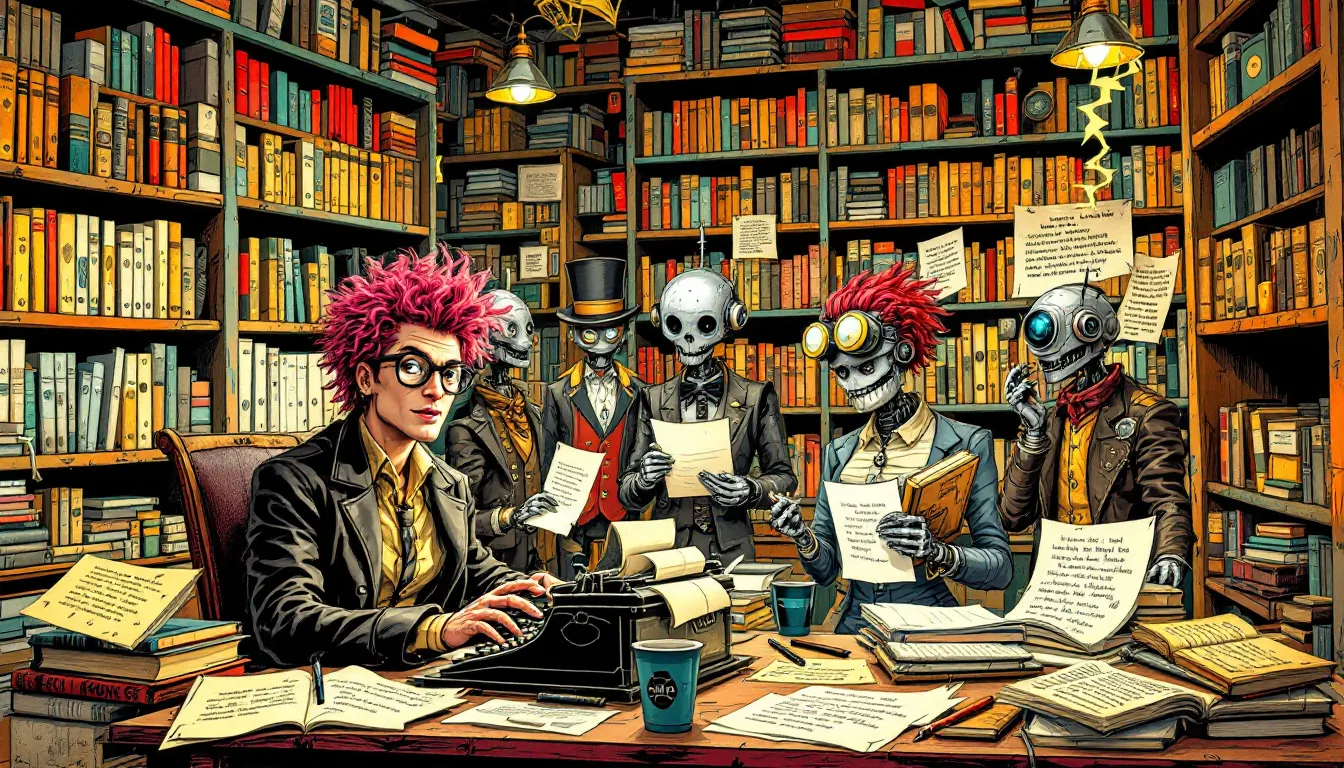The Benefits of Indie Publishing: Why Choose This Path for Your Book?
Mar 27, 2025
Top 10 Tips for Success in Indie Publishing
In the ever changing publishing world what is indie publishing? Simply put its a way for authors to publish their books without traditional publishers and the terms they offer. This guide covers what you need to know about indie publishing, its benefits and tips for success.
Key Points
-
Indie publishing offers faster publishing timelines and higher royalty rates than traditional publishing, allows authors to keep creative control.
-
Well thought out marketing strategies such as using social media and building an email list are necessary for indie authors to get visibility and sales.
-
Choosing the right independent publisher can provide personalized support and full services, helps an indie author to succeed.Understanding Indie Publishing houses.
What is Indie Publishing?

Independent publishing, also known as indie publishing, is where authors bring their work directly to the market by self publishing thier book but with the help of a company who offers services and stronger royalty rates to help authors get thier book out into the world.
With the rise of Kindle eBooks over the past two decades this has flourished, allowing writers to take on the role of publishers themselves and carve out its niche in hybrid publishing models.
This option of publishing is appealing for many reasons including faster publication times and more control over the book content and marketing. Authors who want to have creative control over their work and higher royalty rates for each book sold can puruse this option.
Indie Publishing vs Self Publishing
Indie publishing and self publishing, while often used interchangeably, are different. Self published authors own the full book production and will need to source those who can assisted with editing processes and financial investment in quality services. In self publishing the author is responsible for all aspects of the publication process from the writing phase to marketing their work.
Indie authors will hire professional services that may include editing, formatting or cover design. This allows authors to leverage their special skills and focus on what they do best.
Self publishing can be very fulfilling as it gives writers full autonomy at every stage of the author journey. But this path requires comprehensive editing and a good marketing plan if you want to succeed. Indie publishing strikes a balance by providing support and resources while still giving writers a lot of control over how their projects are managed and brought to market.
Indie Publishing vs Traditional Publishing
Indie publishing is the opposite of the traditional publishing process which is a long and arduous journey for authors. It offers an advantage by allowing a faster process to release books. With traditional publishing authors can experience a longer publication timeline – find an agent, pitch to publishers, get an acceptance letter and wait for royalties months after sales. Indie authors can submit their work for publication directly, eliminating the need for literary agents and reducing time to market.
Publishers in the traditional sphere focus on market trends and prefer an established author platform – they only accept a limited number of submitted proposals – indie publishing has fewer barriers to entry. This gives writers more freedom to bring passion projects to life without being limited by commercial constraints.
Financial Aspects of Indie Publishing

Understanding the financial aspect of publishing is essential for writers, and those who choose the indie route benefit from specific fiscal perks. Indie authors frequently enjoy higher average earnings compared to their counterparts in traditional publishing because they receive more generous royalty rates and have the flexibility to price their books competitively.
On the flip side, monetary limitations can present obstacles since authors will need funds for professional editing services as well as marketing and promotional activities. Taking the time to understand the costs associated with indie publishing gives authors the ability to make choices that could increase their profits.
Royalties and Earnings
The possibility of earning higher royalties is appealing for indie authors when compared to their traditionally published counterparts. Indie publishers generally offer royalty rates between 40% and 60%, which contrasts with the approximate 10% to 15% that traditional publishers provide. As an example, an indie author could receive around $5 from a book priced at $15, whereas a traditionally published author might earn just $1.
When vetting independent publishers, carefully review the contract terms outlining the royalty percentages and payment timelines. Fully understanding the agreement terms ensures authors maintain control over their work’s profits, intellectual property, and achieving greater profits publishing.
Marketing and Promotion
Marketing and promotion are absolutely essential when indie publishing. Independent authors must take an active role in promoting their books to their desired audience, as they lack the support of sales teams typical within established publishers. Building out an author brand and platform and implemented marketing activiites that increase the visiblity for reader interaction will make or break a books success. Either way you publish you will need to bulid our your own marketing team.
Developing a personal author platform on various social media channels and maintaining direct contact with readers can greatly improve promotional endeavors. Establishing a distinctive author brand coupled with rallying community support can elevate an indie author’s profile along with book sales.
Independent publishers frequently provide custom marketing strategies which assist authors in successfully maneuvering through the challenging marketplace, enabling them to effectively reach out to their readers even when operating as small publishers.
The Indie Publishing Process
The indie publishing process is similar to any book publishing process but you indie authors will be overseeing steps they wouldn’t with traditional publishing. They have full control over every aspect of their publishing journey from getting the manuscript ready to cover design to distribution.
Manuscript Preparation
Success in indie publishing is meticulous manuscript prep. Taking the right steps and hiring the right people to do the editing and proofreading will make your manuscript professional and attractive on launch. Various types of editing – developmental and copy editing – play different roles in polishing different parts of your manuscript.
Having beta readers can give you valuable insights into the organizational coherence and narrative flow of your text. Many independent publishers offer access to skilled editors who will ensure your work meets high standards and connects with your audience.
Cover Art and Design
Hiring a designer to create a cover for your book will make your book stand out in the competitive publishing landscape of your genre. A great cover not only makes your book appealing but also convinces readers to take a look and buy.
Publishers for independent authors often offer services like cover design and formatting that cater to the unique needs of indie authors. Working with cover designers through these publishers can greatly enhance your book’s visuals and increase its chances of attracting readers.Whether through digital platforms like Amazon or print-on-demand options, independent authors no longer have a barrier to entry to reach a wide audience.
Having multiple channels of distribution allows independent authors to go beyond the standard bookstores. This benefit of indie publishing gives writers more chance to connect directly with their target audience.
Creative Control in Indie Publishing

Indie publishing gives authors more creative control to shape their stories and design their book as they best see fit. This is different from the restrictions found in traditional publishing. With this approach indie authors can still can work with a team but explore different options to see what will best fit for thier style and narritive.
Editorial Decisions
Authors who publish independently have the freedom to write their stories and decide on content without being tied to editorial guidelines. This level of control allows authors to shape their narrative their way. They can change their manuscript as needed and stay true to the essence of their original idea.
Having control over all editing decisions means indie writers can keep their finished work close to what they originally intended and envisioned artistically. That’s a big bonus for these authors.
Artistic Expression
Authors in the indie publishing world can try different ways to design their book and cover image. This creative freedom brings diversity and innovation and highlights unique perspectives in the indie publishing world.
This freedom to choose genres and narrative techniques enables indie authors to produce literature that matches thier voice. The artistic expression found among independent writers sets them apart from their traditionally published authors where content is often shaped by market trends.
Finding the Right Independent Publisher
Choosing the right publisher as an indie author is one of the most important decisions you will make. These publishers range from university presses to genre-specific publishers and can offer specific support and promotional strategies that differentiate them from self-publishing.
The next section helps you as you navigate how to research indie publishers to get a positive and successful relationship.
Researching Publishers
The first step in getting the right publisher for your manuscript is to research potential publishing houses. Independent publishers are willing to take on unique content, often favoring creative merit over commercial viability unlike their bigger counterparts. Immersing yourself in indie author groups can give you valuable connections and awareness of what’s trending in publishing.Connecting with other writers through community forums and attending meetups are great ways for indie authors to stay up to date with industry news and network with potential publishers.
Connecting with other writers through community forums and attending sector-specific gatherings are key actions for indie authors to stay informed about industry trends and connect with potential publishers.
Services
When looking for help with the publication process, authors must research the services offered by independent publishers. These publishers have customized services and book marketing strategies that differentiate them from self-publishing but at cost.
Choosing a publisher like Forbes Books gives an author a unique set of content designed for authors in that genre.
When evaluating their services, consider how much support they offer with editing, cover design and marketing for your specific genre. Choosing a publisher that offers all of these services for authors like yourself can potentially increase the success of your work.
Contracts
Understanding the contract details is just as important with an independent publisher as with a traditional publisher. Authors should have complete rights to their work in the publishing agreement which safeguards their creative control and financial compensation. Authors should negotiate contracts that get them a high royalty if possible.
Be sure to that you have the final say on content decisions in your contract is part of any deal to confirm the finished product is what you intended. The contract should clearly outline the services provided by the publisher. This prevents any miscommunication and expectation from being broken and gives you clarity if any unexpected charges should arise.
Case Studies

From fan fiction, E.L. James moved into indie publishing and became an international sensation with her Fifty Shades trilogy, which astonishingly sold over 165 million copies worldwide.
Andy Weir’s indie published book The Martian not only became a bestseller but also a feature film.
These examples show how indie authors can get significant recognition and big money.Colleen Hoover’s first book in the literary world Slammed earned her $55,000 in royalties in just 7 months – a testament to the financial potential of self-publishing.
Hugh Howey shows this trend. His self-published science fiction novel Wool got him a traditional publishing deal.
These stories prove indie publishing can lead to even greater opportunities.
Lessons Learned
Many indie authors have found success despite being rejected by traditional publishers, so kep at is as you find a place for your book in the publishing world. Michael J. Sullivan’s story is proof that even after being rejected several times, persistence can lead to success through self-publishing. Mark Dawson shows the importance of connecting with readers directly by incorporating their feedback into his writing process.
These examples demonstrate three key principles for success in indie publishing: unwavering commitment, creativity and active reader engagement. If you can master these you can overcome the obstacles of the publishing landscape and achieve your goals.
Common Problems and How to Fix Them
Indie authors face many common problems along thier journey. A few of them are time management, marketing and adapting to industry changes. Maintaining motivation and discipline is a skill all authors need to develop.
Time Management
Balancing a day job and writing requires authors to set priorities and a routine for writing. Using productivity apps can help you track your writing time while juggling other responsibilities.
Using time-blocking writing strategies enables writers to allocate chunks of time to specific tasks which increases efficiency and prevents burnout from overworking.
Setting realistic goals in your routine will help keep you motivated as you integrate your book writing with your daily life responsibilities.
Marketing Strategies
To get more visibility for your books indie authors must choose the right marketing strategies. Consider these:
-
Use social media to engage with your audience and promote your writing.
-
Target your advertising to specific campaigns to increase your indie books visibility.
-
Start building an email list as soon as possible so you can communicate with fans and market new releases.
Using these methods will greatly increase an indie author’s chances of success in a crowded market.Amanda Hocking is an example. Despite initial challenges with self-publishing, her paranormal romance novels became New York Times bestsellers due to her savvy use of marketing tools.
By diving into available marketing resources and connecting with readers directly indie writers can build a loyal fan base that contributes to their commercial success.
Navigating the Publishing Landscape
Staying up to date with publishing technology can help reduce time spent on tasks that have usually taken a lot of hte authors time. A full understanding of every step in the indie publishing process can impact an author’s success along the way. Participating in online forums and keeping up with industry changes can provide invaluable advice and encouragement to indie authors.
Writers embarking on the indie publishing path will learn that each step they are involved in will increase thier knowlege and thier chances of a successful book launch. By keeping up with the literary world and learning from fellow indie authors’ successes and failures, writers can navigate this dynamic environment to achieve their publishing goals.
Summary
Indie publishing gives authors full creative control, higher royalties and a direct line to their audience. Knowing how indie publishing differs from self-publishing and traditional publishing enables writers to choose the best route for their work. Keeping up with finances, competence in the indie publishing process and marketing skills are the keys to success in this space.
Authors who persist with creativity and initiative can overcome the obstacles along the way to author fulfillment. Start your own indie publishing journey now – publish your unique stories to a global audience.
FAQs
What is an indie author?
An indie author is someone who self-publishes their books and keeps full control of their rights and aims to make a living from their writing.
They’re all about taking control of their own journey!
Do you have to pay an indie publisher?
Yes, many indie publishers require upfront payment but they give you more control over your royalties and pricing.
So it can be a worthwhile investment for your work!
Is indie publishing worth it?
Yes, indie publishing can be worth it, especially since you can earn 50% royalties compared to 15% from major publishers.
You’ll also see your earnings sooner which is a nice bonus!
What does it mean to be indie published?
Indie published means you’re self-publishing your work and keeping control of your rights.
It’s all about producing and selling to make a living from your writing.
What is indie publishing?
Indie publishing means publishing on your own without big publishers. It’s all about freedom and often small presses or self publishing.
Stuck Knowing How to Publish Your Book?
Take the quiz to Discover the Ideal Book Publishing Path for You


